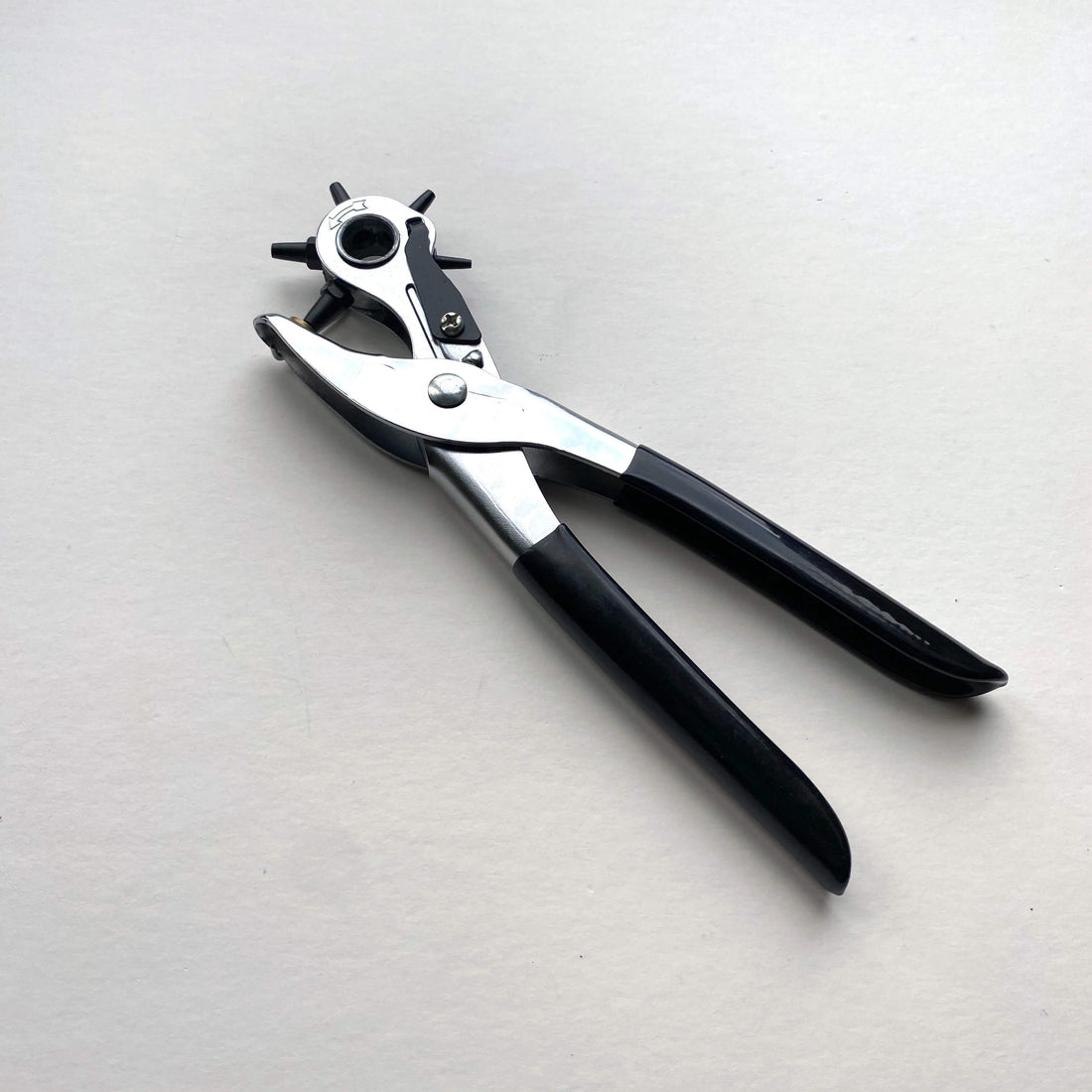
A Beginner's Guide to Punching Perfect Holes in Leather
A Beginner's Guide to Punching Perfect Holes in Leather
Working with leather can be incredibly rewarding, whether you're crafting a bespoke belt, repairing favourite footwear, or creating unique accessories. One of the most fundamental skills you'll need to master is punching clean, precise holes in leather. This comprehensive guide will walk you through everything you need to know about leather hole punching, from choosing the right tools to achieving professional results.
Why Proper Hole Punching Matters
The quality of your holes can make or break a leather project. Poorly punched holes can weaken the leather, create unsightly tears, or compromise the durability of your finished piece. Professional-looking holes, on the other hand, ensure your leather goods will stand the test of time whilst maintaining their aesthetic appeal.
Whether you're adjusting a belt to fit perfectly or creating decorative patterns in leather craft projects, understanding the nuances of hole punching will elevate your work from amateur to artisan level.
Types of Leather Hole Punchers
Rotary Punch (Revolving Punch)
The rotary hole punch is arguably the most versatile tool in any leather worker's arsenal. This handheld device features a rotating wheel with multiple punch sizes, typically ranging from 2mm to 4.5mm in diameter.
Best for: Belt making, watch straps, and general leather crafting where multiple hole sizes are needed. The rotary punch excels at creating clean holes near edges and in tight spaces.
Advantages: Multiple sizes in one tool, excellent leverage, precise control, and the ability to punch close to edges.
Limitations: Limited to smaller hole sizes and may struggle with very thick leather.

Drive Punches (Round Punches)
Drive punches are individual tools that create holes of a specific size. They consist of a sharp, hollow tube that you strike with a mallet to cut through the leather.
Best for: Creating larger holes, working with thick leather, and situations where you need perfectly round holes of a specific size.
Advantages: Available in a wide range of sizes (from 3mm to 25mm+), excellent for thick leather, and produce very clean holes.
Limitations: Require a cutting mat and mallet, and you need separate punches for different sizes.

Prong Punches (Chisel Punches)
Prong punches (or stitching punches) are specialised tools that create multiple holes simultaneously and are primarily used for stitching preparation. They come in various prong configurations, typically 1, 2, 4, or 6 prongs.
Best for: Creating evenly spaced holes for hand stitching leather goods like wallets, bags, and belts.
Advantages: Ensure consistent spacing, speed up the stitching preparation process, and create angled holes that improve stitch appearance.
Limitations: Primarily designed for stitching holes rather than functional holes.

Awls and Leather Needles
Whilst not technically punches, leather awls are essential for creating small pilot holes or enlarging existing holes.
Best for: Fine detail work, creating small holes for decorative stitching, and preparing leather for other punching tools.
Advantages: Excellent control, minimal leather removal, and perfect for delicate work.
Limitations: Limited to very small holes and require significant manual effort.

Hydraulic and Lever Punches
These heavy-duty tools use mechanical advantage to punch through even the thickest leather with minimal effort.
Best for: Industrial applications, very thick leather, and high-volume production work.
Advantages: Can handle extremely thick materials, require minimal physical effort, and produce consistent results.
Limitations: Expensive, bulky, and often overkill for hobbyist projects.
Essential Techniques for Perfect Holes
Preparation is Key
Before you begin punching, ensure your leather is properly prepared. Clean the surface and mark your hole positions accurately using a ruler and awl or leather marking pen. For belt making, use a belt end punch or template to ensure holes are evenly spaced and properly aligned.
Choosing the Right Punch Size
For belts, the standard hole size is typically 4mm to 5mm, which accommodates most belt buckle tongues. However, always check your specific buckle requirements before beginning. For decorative work, smaller holes (2mm to 3mm) often provide a more refined appearance.
Proper Punching Technique
When using a rotary punch, position the leather between the punch and anvil, ensuring the material is flat and properly aligned. Apply steady, firm pressure in one smooth motion. Avoid twisting or rocking the punch, as this can create oval-shaped holes or tear the leather.
For drive punches, place the leather on a suitable cutting mat (preferably end-grain wood or a specialised leather hole punching board). Position the punch perpendicular to the leather surface and strike it sharply with a mallet. A single, decisive blow typically produces better results than multiple light taps.
Avoiding Common Mistakes
One of the most frequent errors is attempting to punch holes in leather that's too dry or stiff. Slightly dampening thick leather can make punching easier and reduce the risk of cracking. However, avoid over-wetting, as this can cause the leather to stretch and distort.
Another common mistake is using dull punches. Sharp tools create clean holes with minimal effort, whilst dull punches can crush fibres and create ragged edges. Regularly maintain your leather punches by keeping them clean and sharp.
Specific Applications: Belt Making
When creating or modifying belts, hole placement is crucial for both function and aesthetics. Standard belt holes are typically spaced 25mm (1 inch) apart, starting approximately 150mm (6 inches) from the buckle end.
For a new belt, create five holes initially, with the middle hole positioned where the belt will most commonly be worn. This provides two holes for adjustment in either direction, accommodating weight fluctuations or different clothing thicknesses.
When punching belt holes, use a rotary punch with a 4mm to 5mm tube for most applications. Ensure the holes are centred on the belt width and maintain consistent spacing throughout.
Advanced Tips for Professional Results
Backing Materials
When punching holes, especially with drive punches, use an appropriate backing material. End-grain hardwood blocks provide excellent support and help create clean exit holes. Avoid punching on hard surfaces like concrete or metal, as these can damage your punches and create rough hole edges.
Hole Finishing
After punching, inspect each hole for any rough edges or incomplete cuts. Use a small piece of fine sandpaper or a leather burnisher to smooth any imperfections. For decorative applications, consider using edge paint or edge burnishing to create a professional finish around each hole.
Template Usage
For projects requiring multiple identical pieces or precise hole placement, create templates from cardboard or thin wood. This ensures consistency across your work and speeds up the marking process.
Maintenance and Care of Your Tools
Proper tool maintenance is essential for consistently good results. Clean your punches after each use, removing any leather debris or moisture. Store them in a dry environment to prevent rust, and occasionally apply a light coating of oil to metal surfaces.
Sharpen drive punches when they begin to produce rough holes or require excessive force. This can often be done with fine sandpaper or a sharpening stone, working carefully to maintain the original angle and shape.
Safety Considerations
Always work on a stable surface and maintain control of your tools. When using drive punches and mallets, be aware of your hand positions and ensure fingers are well clear of the striking area. Wear safety glasses when appropriate, particularly when working with harder leathers that might produce debris.
Store sharp tools safely, preferably in a dedicated tool roll or box where they won't be damaged or cause injury.
Conclusion
Mastering the art of punching perfect holes in leather is a fundamental skill that will serve you well across countless projects. Whether you're crafting your first belt or working on intricate leather goods, the techniques and tools outlined in this guide will help you achieve professional results.
Remember that practice makes perfect. Start with scrap leather to refine your technique before moving on to your final projects. With patience and the right approach, you'll soon be creating clean, precise holes that enhance both the functionality and appearance of your leather work.
The investment in quality punching tools will pay dividends in the quality of your finished pieces. Take time to choose the right tools for your specific needs, maintain them properly, and your leather crafting journey will be both more enjoyable and more successful.
-------------------------------

Original article by Becky Cocker, leather artisan and owner of British Leather Supplies. Becky is a trained leather worker and has been running a successful leather fashion brand for over a decade. If you'd like to explore a curated selection of quality leather tools, including leather punches, check out our leather craft tool collection at British Leather Supplies.
